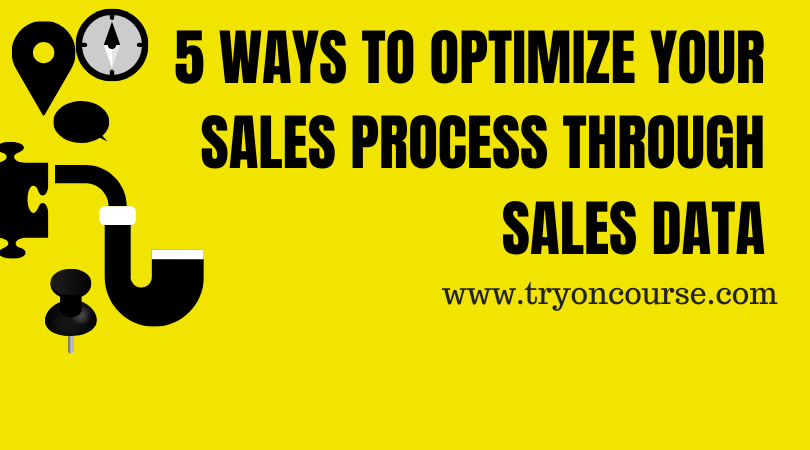
You collect all these sales data, but are you making the most of them? Do you use your data to help you make smarter choices and boost your business?
You can collect junk data along with the valuable material. Make it a priority to gather clean data , base your decisions on analytics and use this insight to impact your company positively.
Your data is the key to the optimization of your marketing engine and to the beginning of the sales process. It doesn't make sense to look elsewhere when you have a customer relationship management tool (CRM). Look to your CRM.
Optimizing the sales process simply means relying on your current sales plan and fixing the strategy that doesn’t work.
In this article, I'll show you 5 realistic strategies for any company that you can use to boost your sales process.
1. Look at the big picture
It's easy to focus on the specifics as a sales manager. Between the careful management of sales goals and the success of each sales team member, managers frequently lose track of the big picture.
The outcome? Sales teams operate individually, not collectively.
To minimize this, ensure that every aspect of your sales and every member of the team has the same vision as yours. You have to make sure that everyone is running in the same direction, chasing the same goal.
This means everyone is familiar and has a sound knowledge of the following:
- Game plan: Where does the product head? What's the specific strategy for selling? How is the market environment as a whole? The sales team will understand the business and see how its input affects the entire company by understanding these important factors.
- Key indicators: Hard numbers are respected by salespeople. You should know the entire sales team's key features such as performance of each member of the team, short- and long-term goals.
- Marketing versus sales: Your sales team must know where the responsibility of the marketing department ends and where theirs starts. This is crucial to all businesses.
It doesn’t matter if you are a startup or an enterprise in terms of revenue, focusing on the big picture will help the sales team feel like they're trying to win something greater than individuals.
2. Develop a process for tracking KPIs

Usually there are two kinds of sales organizations: those without sales information and those which sink into details.
Both of these conditions are not desirable. A lack of data results in poor visibility, while there is uncertainty about too much data.
In order to be effective, it is important to identify and quantify information that really matters.
The people you want to accept personalized marketing messages are customers. Segregate it according to the type of industry and their work profile, interests and so on. Ensure that public data is monitored and segmented into the audience to analyze the KPIs that are most successful.
This is a three-stage method in broader terms:
- You probably already know the KPIs as a sales manager, but it doesn’t hurt to search out and recognize metrics that improve the performance relative to other metrics.
- Collection and monitoring of data: This is probably the toughest step. A lot of sales professionals say the management of information is their greatest CRM problem. Because sales representatives lack data entry, it is difficult to collect data correctly. Try to improve data quantity and quality by using better software and automated data collection. The greatest loss of time is manual data tracking, and your sellers spend so much time away from their customers. Automated data collection saves time and provides all the information you want.
- Data Cleaning: The last step is the regular auditing of data and the deletion of incorrect, obsolete or unwanted information. This not only improves performance, but also prevents your representatives from drowning in data.
- Monitoring these over time often allows you to monitor improvement in critical areas of the sales process.
Stick to ‘one process’
Think: each member of your sales team pursues various metrics. SDRs go after the customer satisfaction rate. Outbound members chase the operation metrics.
Often this means that sales companies have no single metric behind them, which results in uncertainty and discouragement. Establish a common route. You want to shorten your sales cycle to save money; that’s understandable. Try looking at conversion rates between stages to see where your cycle can be shortened.
Reflect on the efforts of your sales team to improve the process. Once you’ve figured out the process that works best for your team, then move on and repeat the process. Improving key metrics over time means a more efficient team and a more reliable sales pipeline.
Your company must identify possible pain points, barriers that can hinder sales early in the sales process. Sales managers should take the time to address the pipeline with in order to set a good sales strategy and to obtain incremental commitment.
Ships don’t sink because of the water around but the water that gets in; find the holes in your sales funnel so your sales don’t sink
Sales managers usually understand the bottom of the funnel very well. This is, after all, the place where you win.
The inherent simplicity of the funnel also ensures that the remainder of the pipeline is overlooked. Leaks at the top of the funnel can affect your level of success later on and perhaps you don't even know.
Therefore, mapping the entire funnel and repairing the gap in your pipeline is important. Visualizing each phase and the entire customer journey in the funnel will help you identify and strengthen the weak areas.
Customize your sales process according to the needs of your target audience

Because sales has changed drastically, the sales process is managed by consumers rather than salespeople. With the amount of information available online, consumers do not need sales representatives to remind them about products and services. Unfortunately, most sales companies, which do not operate at the client-first era, are still using old selling processes. What can you do to fix this?
Enhance marketing cooperation: the gap between sales and ads is fluctuating. Sales should work closely with marketing to map the path of the consumer, create relevant content and promote demand to meet its consumers in the information age.
It’s the social media era: Change is the only constant thing in every area of life; therefore, it is wise to adapt to platforms that your target audience engages in. Go where your customers go.
Content marketing:

Since your customers are seeking search engine and social media solutions, the creation of content is critical for your sales team. encourage the sales team to create their own content or at least bring it to advertising to produce content that is more important and sales-oriented.
You will see an increase in sales efficiency and improved overall revenue through the introduction of client-first sales.
In conclusion
Don't try to tackle everything all at once. Use this as a blueprint and automate step-by-step. Concentrate on being better than yesterday and rising steadily time.
Accelerating the production of the sales pipeline is information that contributes to entering and nurtures the pipeline. It is also about speeding up the sales process to identify the shortcomings, coaching employees and pipeline management of your business.

